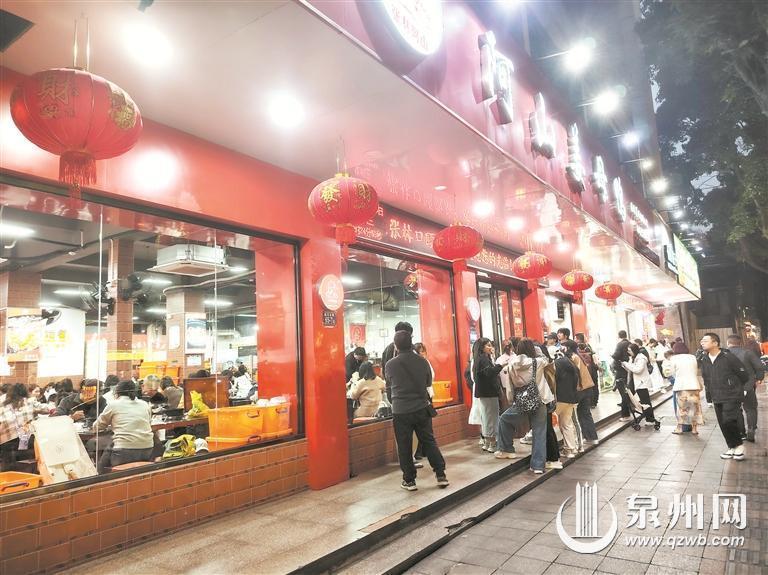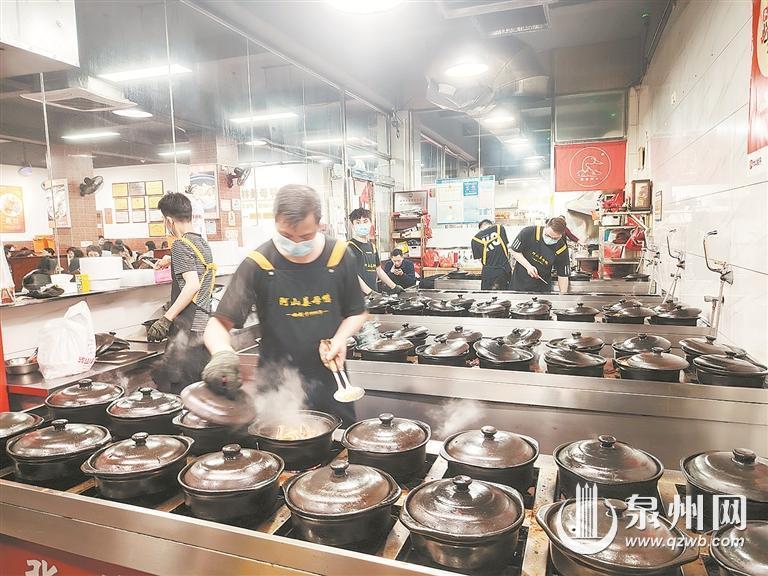- About
- Sustainability

Long queues outside a ginger duck restaurant on downtown , filled with the aroma of sizzling spices.
By Wang Jinzhi & Intern Dai Yuxuan, Quanzhou Daily, April 17
Walk through the lively streets of Quanzhou, and you’ll be greeted by the unmistakable aroma of ginger duck simmering in clay pots. This once-humble dish has become a viral sensation, capturing the hearts—and appetites—of both locals and visitors. Its popularity has grown so widespread that some jokingly say: “You’ll smell ginger duck before you see the city.”
But how did ginger duck become Quanzhou’s culinary calling card? What challenges lie beneath the surface of its success? And what does the future hold for this hometown favourite?
A Culinary Star: From Local Comfort Food to National Fame
As Quanzhou rises as a destination for cultural tourism, its food scene has gained nationwide attention. Among the many local specialties, ginger duck stands out. The dish is both simple and rich—tender duck slowly cooked with fragrant ginger in clay pots, combining comforting flavours with traditional beliefs in its health benefits.
A Business Booming with Demand
On Xinhua Road, one popular eatery is already buzzing before noon. Sixty-four clay pots bubble away with golden ginger and duck, filling the air with an irresistible aroma. According to owner Su Xiangying, the restaurant sells 200 to 300 ducks daily—and even more during holidays.
The street is lined with dozens of similar restaurants. Across Quanzhou, daily sales exceed 10,000 ducks, peaking at 25,000 to 30,000 during festivals. With prices ranging from 120 to 130 RMB per duck, the annual market size is estimated to surpass 500 million RMB. Over 10 leading brands operate more than 40 locations citywide.

Rows of clay pots bubbling at full heat to meet soaring tourist demand.
Local Success Stories: From Passion Projects to Prosperous Shops
In Quanzhou’s historic West Street district, shop owner Ke Qingbin recalls how his journey began. “I started by making ginger duck at home—my family loved it,” he said. In 2018, he opened a modest 10-square-metre stall. Thanks to glowing reviews and loyal customers, the business quickly grew. By 2024, he had opened a second outlet on Xinhua Road.
“When I began, tourism wasn’t as developed. Few outsiders even knew about ginger duck,” Ke reflected. “Now it’s a must-try for visitors.”
Celebrity Endorsements Bring National Buzz
This year, ginger duck gained new visibility thanks to several celebrity endorsements. On February 20, actress Li Chun—famous for Ruyi’s Royal Love in the Palace and Joy of Life—shared a food vlog on Douyin, calling Quanzhou “a city full of great food and fun,” and spotlighted ginger duck as a highlight.
Just days earlier, Hong Kong actor Philip Ng praised the dish on Weibo after sampling it in Quanzhou, calling it “a must-eat.” Meanwhile, the hit TV drama Return of the Wild Goose featured the dish in a key episode, giving it additional pop-culture clout.
Tourists Flock to Taste
During the Qingming Festival holiday, lines formed outside many of the city’s oldest ginger duck restaurants. Some tourists followed digital “Quanzhou food maps” in search of this signature dish.
“It’s not about fancy food—these small local dishes leave the deepest impression,” said Mr Wu from Shantou. “The duck is tender, and the ginger flavour is unforgettable.”
Mrs Yang, who drove in from Fuqing, shared: “We even vacuum-packed three portions to bring home for family!”
One netizen summed it up: “You haven’t truly visited Quanzhou if you haven’t tried the ginger duck.”
Challenges Beneath the Surface
As of March, there are over 250 ginger duck restaurants across Quanzhou, nearly 100 of them in the urban core. While demand is high, the industry faces growing pains—intensified competition, weak brand identity, and supply chain vulnerabilities.
Supply Chain Strains
Most ducks are sourced from other cities such as Sanming, Zhangzhou, and Xiamen, while ginger typically comes from Yongchun and Dehua. This dependence on external suppliers raises questions about consistency and authenticity—two crucial factors in culinary tourism.
Recipe styles vary—ranging from dry to soupy—but the end result often lacks clear differentiation. Prices vary widely too: the Sidan outlet on Tumen Street charges 126 RMB, while another branch near Tianhou Temple sells the same dish for just 85 RMB.
Brand Building and Operational Costs
Despite its popularity, the market lacks a nationally recognised ginger duck brand. Few shops hold official cultural heritage status, limiting their broader appeal. Meanwhile, ingredient costs, rising rents, and staffing expenses create ongoing pressure—especially during off-peak seasons.
Entrepreneurs Innovate to Stay Competitive
To stay ahead, shop owners are exploring new flavours, refining operations, and embracing innovation.
Fresh Recipes and Premium Variants
Chen Shuzhen, who runs a local restaurant, said her team adjusted the ginger blend to appeal to a wider range of palates. Ke Qingbin developed new variations like ginger duck with crab roe and ginger duck with abalone—fusing traditional duck with premium coastal ingredients for a richer taste.
“Duck is considered cooling, crab is warming—they complement each other and offer balanced nutrition,” Ke explained.
Seasonal Staffing Strategies
“Business fluctuates with the seasons. We can't afford to keep a large full-time team year-round,” Chen noted. Her solution? Hiring part-time workers during peak periods to manage costs and stay flexible.
Looking Ahead: From Local Dish to Global Brand?
More than just a meal, ginger duck represents the spirit of Quanzhou—resilient, creative, and deeply rooted in tradition. With continued innovation, stronger branding, and the support of the city’s expanding tourism sector, this beloved dish could be poised to earn its place on the global culinary map.
